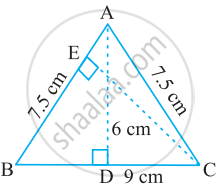Advertisements
Advertisements
प्रश्न
Show that the points O(0,0), A`( 3,sqrt(3)) and B (3,-sqrt(3))` are the vertices of an equilateral triangle. Find the area of this triangle.
उत्तर
The given points are O(0,0), A`( 3,sqrt(3)) and B (3,-sqrt(3))` .
`OA = sqrt((3-0)^2 +{ (sqrt(3)) -0}^2) = sqrt((3)^2 +(sqrt(3))^2) = sqrt(9+3) = sqrt(12) = 2sqrt(3) `units
`AB = sqrt((3-3)^2 +(-sqrt(3)-sqrt(3))^2) = sqrt((0) + (2 sqrt(3))^2) = sqrt(4(3)) = sqrt(12) =2sqrt(3)` units
`OB = sqrt((3-0)^2 + (-sqrt(3) -0)^2) = sqrt((3)^2 +(sqrt(3)^2) = sqrt(9+3) = sqrt(12) = 2 sqrt(3)` units
Therefore, `OA =AB = OB = 2 sqrt(3) ` units
Thus, the points O(0,0), A`( 3,sqrt(3)) and B (3,-sqrt(3))` are the vertices of an equilateral triangle Also, the area of the triangle `OAB = sqrt(3)/4 xx (" side")^2`
`=sqrt(3)/4 xx(2 sqrt(3) )^2`
`= sqrt(3)/4 xx 12`
`= 3 sqrt(3) ` square units
APPEARS IN
संबंधित प्रश्न
The two opposite vertices of a square are (− 1, 2) and (3, 2). Find the coordinates of the other two vertices.
Let A (4, 2), B (6, 5) and C (1, 4) be the vertices of ΔABC.
(i) The median from A meets BC at D. Find the coordinates of point D.
(ii) Find the coordinates of the point P on AD such that AP: PD = 2:1
(iii) Find the coordinates of point Q and R on medians BE and CF respectively such that BQ: QE = 2:1 and CR: RF = 2:1.
(iv) What do you observe?
(v) If A(x1, y1), B(x2, y2), and C(x3, y3) are the vertices of ΔABC, find the coordinates of the centroid of the triangle.
ΔABC is right angled at A (see the given figure). AD is perpendicular to BC. If AB = 5 cm, BC = 13 cm and AC = 12 cm, Find the area of ΔABC. Also find the length of AD.

ΔABC is isosceles with AB = AC = 7.5 cm and BC = 9 cm (see the given figure). The height AD from A to BC, is 6 cm. Find the area of ΔABC. What will be the height from C to AB i.e., CE?

Prove that the points (2a, 4a), (2a, 6a) and `(2a + sqrt3a, 5a)` are the vertices of an equilateral triangle.
Prove that the points (a, b), (a1, b1) and (a −a1, b −b1) are collinear if ab1 = a1b.
Find a relation between x and y, if the points A(2, 1), B(x, y) and C(7,5) are collinear.
If the centroid of ΔABC having vertices A (a,b) , B (b,c) and C (c,a) is the origin, then find the value of (a+b+c).
The area of a triangle with vertices (a, b + c), (b, c + a) and (c, a + b) is ______.
Let a vector `αhati + βhatj` be obtained by rotating the vector `sqrt(3)hati + hatj` by an angle 45° about the origin in counter-clockwise direction in the first quadrant. Then the area of triangle having vertices (α, β), (0, β) and (0, 0) is equal to ______.
